Walking the streets of Japan:
1. The Japanese do not eat while walking. When one eats while walking, especially in crowded places, there is a possibility of bumping into another person and spilling food or drink on them. Thus, the Japanese consider it impolite to eat while walking.
Most mornings I would leave the hostel early and would buy food for breakfast from a convenience store, but then, if the convenience store didn't have a sitting area, I'd have a problem: where could I eat my breakfast? My options were to eat standing outside the convenience store or find a park where I could sit down and eat.
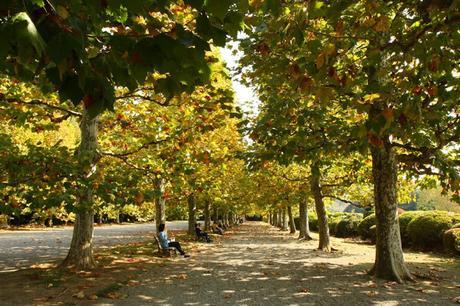
2. There are no trash bins in sight along the streets of Japan yet the surroundings are clean and free of rubbish. I only saw trash bins by the door (or sometimes, inside) of convenience stores. I'd also see bins next to vending machines for drinks, but these bins were for specific bottles or cans only. Whatever trash the people have they make sure to throw it in the proper bin or, if they can't find a trash bin nearby, they just bring it home and sort it properly (sorting trash is a whole new ballgame in Japan).
3. They have 5-way / 6-way crosswalks, making it a cinch to get from one street corner to the corner diagonally opposite! Forgive my ignorance, but I live in the Philippines where there are no 5-way / 6-way crosswalks and where crossing the street, whether on a pedestrian lane or not, is done at your own risk (risk is lower at the few areas where there are pedestrian signal lights, haha!).
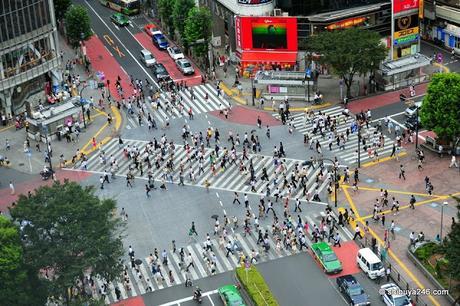 5-way crosswalk at Shibuya. Photo by Shibuya246/Flickr
5-way crosswalk at Shibuya. Photo by Shibuya246/Flickr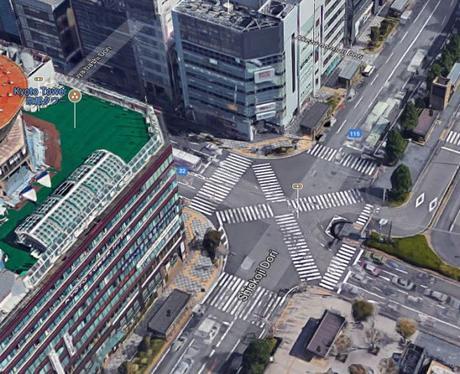 6-way crosswalk at Kyoto Station. Screenshot from Google Maps
6-way crosswalk at Kyoto Station. Screenshot from Google Maps4. Even narrow streets have a crosswalk and pedestrian lights! In just four steps I had crossed a very narrow street in Kyoto and only noticed there was a pedestrian light when I had reached the opposite side.
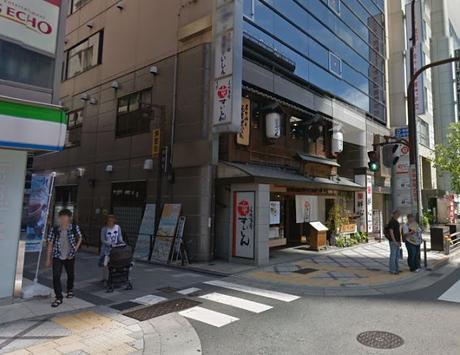 Screenshot from Google Streetview
Screenshot from Google Streetview5. Many people wear a surgical face mask. My first thought was that they were sick and didn't want people to catch whatever they have. A bit of googling revealed that another reason for wearing a surgical face mask was to avoid getting sick. And some wear it just because. (In the Philippines, people have started wearing masks, but I believe it's to protect themselves against dust and air pollution.)
On my trip in late November 2016, my body was adjusting to the low temperature causing my nose to run. While waiting for Horyuji Temple in Ikaruga Town in Nara to open, an old lady stopped to talk (by talk, I mean communicate with hand gestures) with me. In the middle of our "conversation", I sniffed, and she pointed to me, then to her nose, then made an X with her forearms, and then covered her nose and mouth with her hand. She didn't mean to say I had stinky breath (I'm sure I brushed my teeth!), but that I should wear a mask because I had colds.
 Photo by Hinochika/Shutterstock
Photo by Hinochika/ShutterstockCommuting around Japan:
1. No matter how crowded the station is, everyone knows how to queue, whether getting on the train, taking the escalator, exiting/entering through the turnstiles, etc. So it was quite embarrassing for me when I accompanied Hitomi, a Japanese Couchsurfer, to Cebu South Bus terminal to catch a bus for Oslob. We were first in line and when the bus arrived, everyone behind us just surged towards the bus, fighting to get in through the narrow bus door. Needless to say, we were not the first ones to board. When Hitomi finally got on the bus, two other people squeezed in with her, and her slipper fell off but no one bothered to pick it up and give it to her (everyone was busy elbowing their way in to secure a seat). I told to take a seat and I had to block the way in order to fish out her slipper. When we had finally settled in, she remarked, "It was chaos."
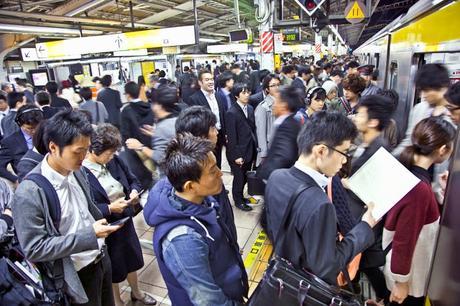 People line up patiently to get in the train. Photo from Fast Japan
People line up patiently to get in the train. Photo from Fast Japan2. On escalators, people stand on one side and keep the other side free to give way to people who are in a hurry. In Tokyo, people stand on the left side of the escalator. In Osaka, people stand on the right side.
3. It's oh so quiet in the bus/train. Nobody talks on the mobile phone while in a public transportation. Everyone keeps to themselves, keeping their eyes glued on their mobile phones, getting some shuteye, or just staring into space. Those who do talk with their companions keep their voices low.
4. Nobody eats inside the train even if there is no sign prohibiting so. With the train shaking and braking, spills are likely to happen. Plus the train cars can smell like food. Like eating while walking, it is also considered impolite to eat and drink in the train.
5. Oftentimes priority/courtesy seats are left empty even if there are no other seats available. Other times, people who sit on the priority/courtesy seat would stand up and give way to those who need it like a pregnant lady, a mother carrying a baby, elderly, and disabled.
6. There are Women Only train cars. Lucky for the ladies they get to ride comfortably when us men would have travel like sardines in other train cars. But I understand they have implemented this so the women would feel safer and not have to worry about perverts groping them in a crowded train car.
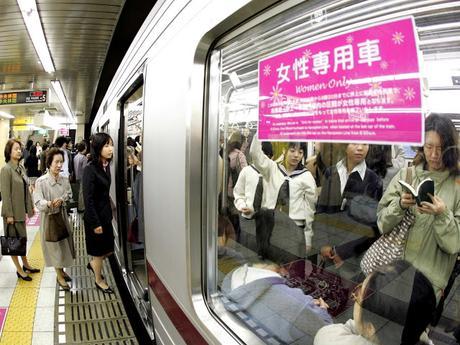 Photo from Business Insider
Photo from Business InsiderJapan
Know Before You Go
Single Entry Tourist Visa for Japan
Roam Around Japan with a Swagger
An Ignoramus in Japan: Vending Machines
An Ignoramus in Japan: Bathrooms and Toilets
An Ignoramus in Japan: Manhole Covers
I Spy With My Little Eye: Japan's Fashion Contradictions
I Spy With My Little Eye: On the Go in Japan (you're here!)
From Tokyo to Hiroshima (2015)
10D/9N | Tokyo, Toyama, Kyoto, Hyogo, Osaka, Hiroshima
Tokyo Accommodation: Shinjuku Airbnb
Tokyo: Memorable Tokyo Eats
Tokyo: Odaiba
Tokyo: Doing Touristy Things in Tokyo
Toyama: A Hamlet Called Ainokura
Kyoto Accommodation: K's House Hostel Kyoto
Kyoto, Japanecdote: Wisdom from the Road: On exits #2
Kyoto: By the Thousands (Kyoto Imperial Palace, Sanjusangendo, Fushimi Inari Taisha, Arashiyama Bamboo Grove)
Kyoto, Japanecdote: Turning Japanese
Kyoto: Braving the Crowds at these UNESCO World Heritage Sites in Kyoto (Kiyomizu-dera, Nijo Castle, Kinkakuji)
Hyogo, Japanecdote: If Only I Could Speak Nihongo
Hyogo: Day Trip to Himeji: Himeji Castle and Shoshazan Engyoji Temple
Hyogo, Japanecdote: Am I an Alien?
Hiroshima: Strolling and Snacking in Miyajima
Hiroshima: Remembering the Past in Hiroshima
Osaka, Japanecdote: How to Lose Friends
Osaka Accommodation: Osaka Airbnb
Osaka, Japanecdote: Where is Bentencho Station?
Osaka: Osaka Adlaw, Osaka Ako sa Osaka
Osaka, Japanecdote: Learn From Your Mistakes
Concentrate on Kansai (2016)
UNESCO World Heritage Sites in the Kansai Region
Kyoto Accommodations: Guesthouse Wind Villa, Shiori Yado
Osaka Accommodations: Hotel Raizan, Hotel Mikado

